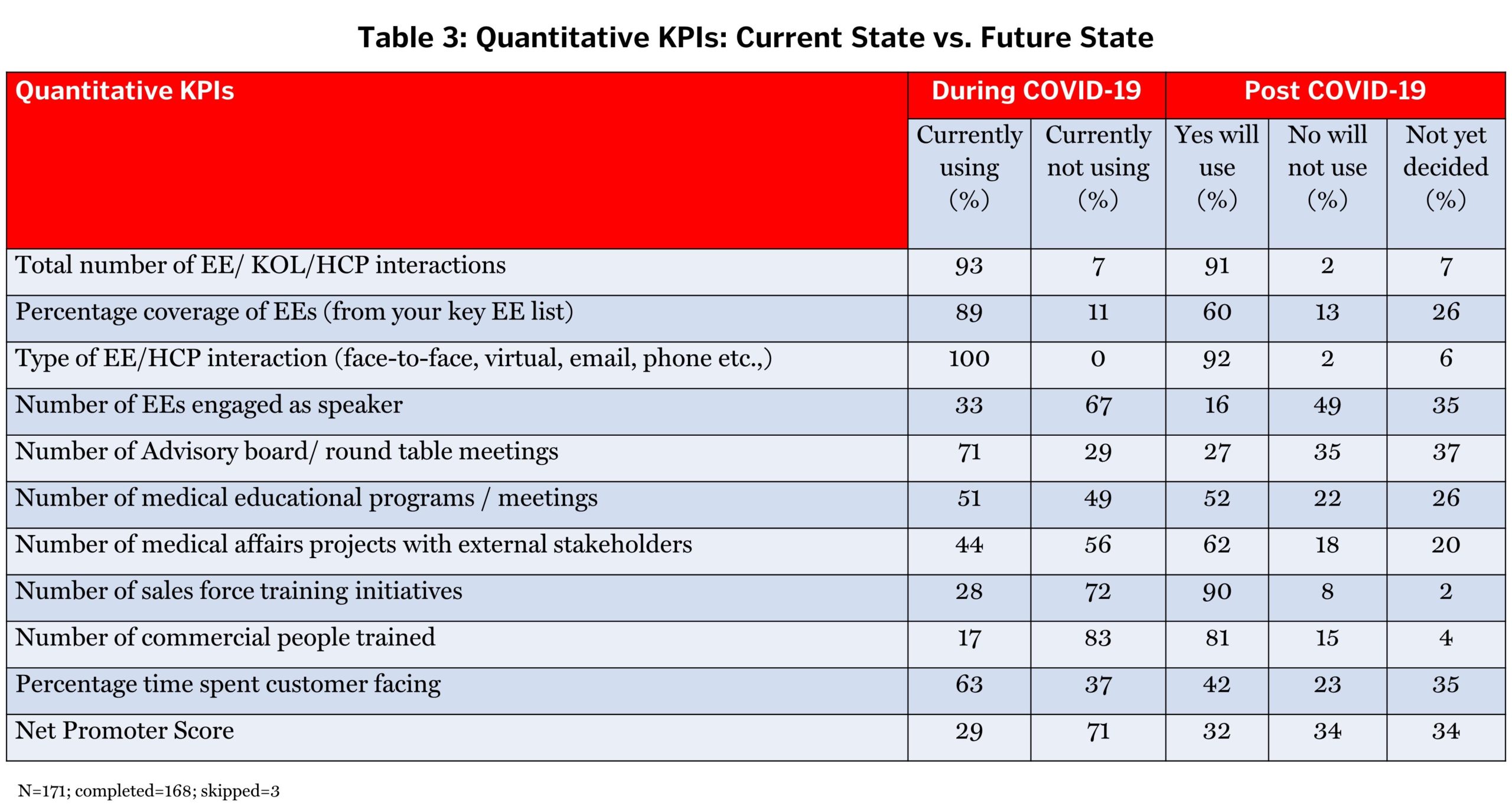Between May 1st and June 1st 2020, we conducted a global survey on whether the COVID-19 pandemic has impacted the way Field Medical Key Performance Indicators (KPIs) are being measured by pharmaceutical organizations. In total, 171 people responded from several pharmaceutical companies from across the world, with more than 80% of the responses from individuals leading field medical teams at a global, regional, or local level and around 20% of the responses from Medical Science Liaisons (MSLs) themselves.
It is an established fact that the MSL/field medical function plays a pivotal role in the success of a drug’s lifecycle.1 MSLs are involved in a number of key activities acting as scientific ambassadors for the organization they represent, exchanging scientific information in a credible, unbiased, and fair balanced manner with external stakeholders.
MSL activities can broadly be classified into internal focused and external customer-focused activities. Table 1 below lists some of the key MSL activities.
External expert engagement forms a major part of their role, with a majority of the MSLs spending between 70% to 80% of their time in customer engagement type activities. Such activities may include, but not limited to one-to-one interaction with healthcare providers (HPCs), including external experts (EEs), both face to face and remotely for the exchange/provision of medical/scientific information, organizing and running advisory boards, roundtables, scientific material design and review, or clinical trial related activities.
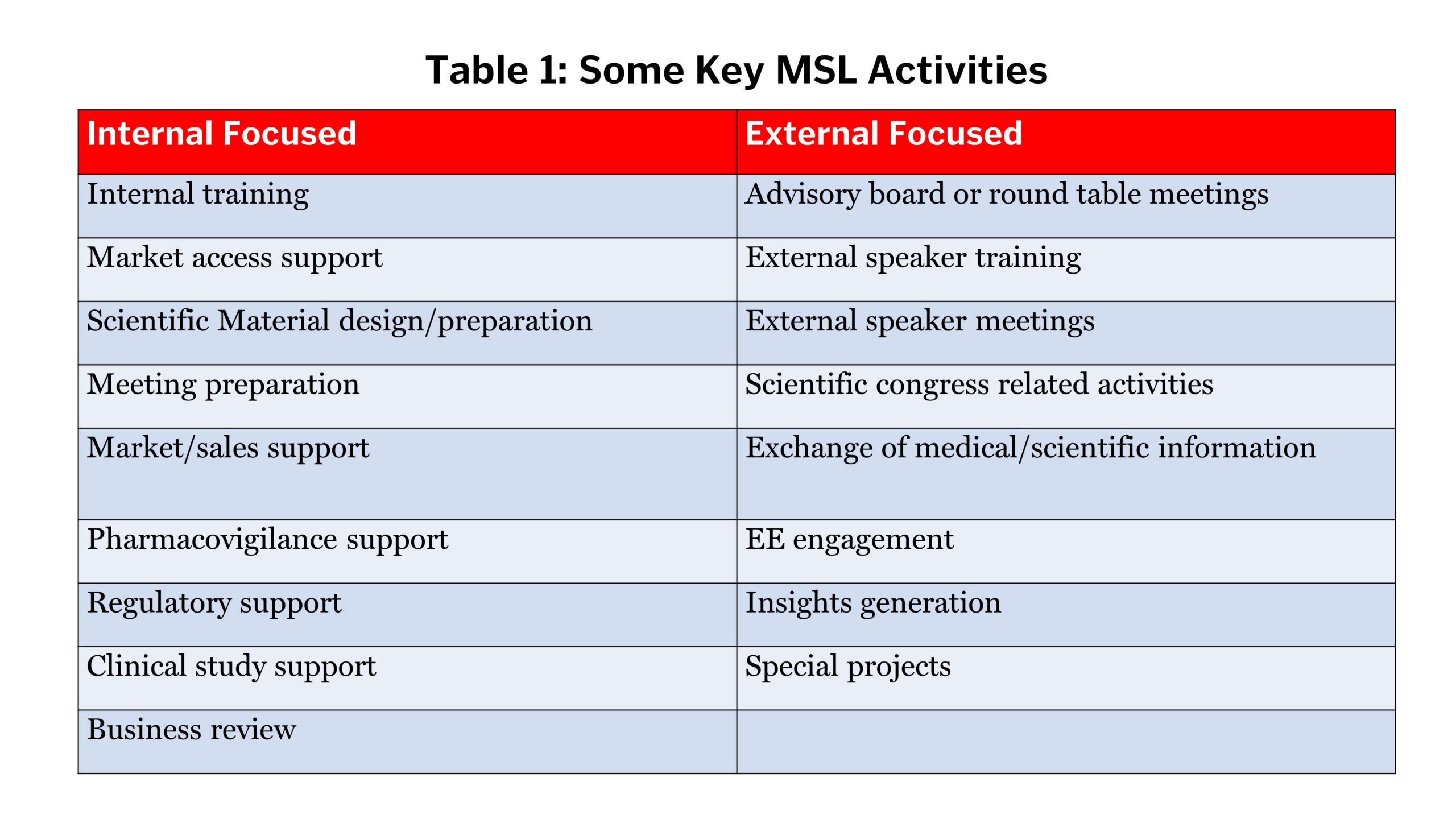 Typically KPIs for MSLs focus on parameters such as proof of high-quality scientific exchange, customer satisfaction/experience, company and brand equity, building relationships with key EEs, and adding value to internal stakeholders. A combination of qualitative and quantitative KPIs are generally used to measure MSL/field medical activities on a monthly/quarterly or a bi-annual basis. Table 2 outlines some of the common qualitative and quantitative KPIs used to measure MSL/field medical activities across pharma companies.
Typically KPIs for MSLs focus on parameters such as proof of high-quality scientific exchange, customer satisfaction/experience, company and brand equity, building relationships with key EEs, and adding value to internal stakeholders. A combination of qualitative and quantitative KPIs are generally used to measure MSL/field medical activities on a monthly/quarterly or a bi-annual basis. Table 2 outlines some of the common qualitative and quantitative KPIs used to measure MSL/field medical activities across pharma companies.
 Scope of Research
Scope of Research
With strict lockdown implemented in many countries across the world since February 2020, and social distancing rules in place, field-based personnel including the MSLs were unable to visit their stakeholders face to face. Dramatic reduction in the number of face-to-face interactions between the pharma industry personnel and external HCPs was reported during the pandemic, and this trend is expected to be continued for a significant period of time even after the lockdown and social distancing measures are relaxed.2 This trend is also seen in our own experience and through anecdotal evidences.
However, an increased emphasis has been made on remotely engaging with HCPs with several pharma organizations making significant investments in digital platforms and digital assets aiding external stakeholder engagements. With this sudden paradigm shift in the way the pharma industry engages with HCPs, we wanted to better understand what medical affairs peers across the world think the impact of COVID-19 will have on MSL/field medical KPIs in the mid- and long-term.
The aim of this research therefore was to identify whether the current COVID-19 pandemic has impacted the selected quantitative and qualitative KPIs that are currently being used to measure MSL/field medical activities, and if so, in what way. The research was also set out to identify what specific elements of MSL/field medical KPIs as perceived by medical and commercial colleagues, have changed or will change in direct relation to COVID-19.
Demographics
The highest number of responses came from Europe, making up 55%, followed by North America (26%), Japan and Asia Pacific (15%), Middle East (3%), and South America (1%). Additionally, 97% of the respondents were from pharmaceutical companies while 3% worked for biotechnology companies.
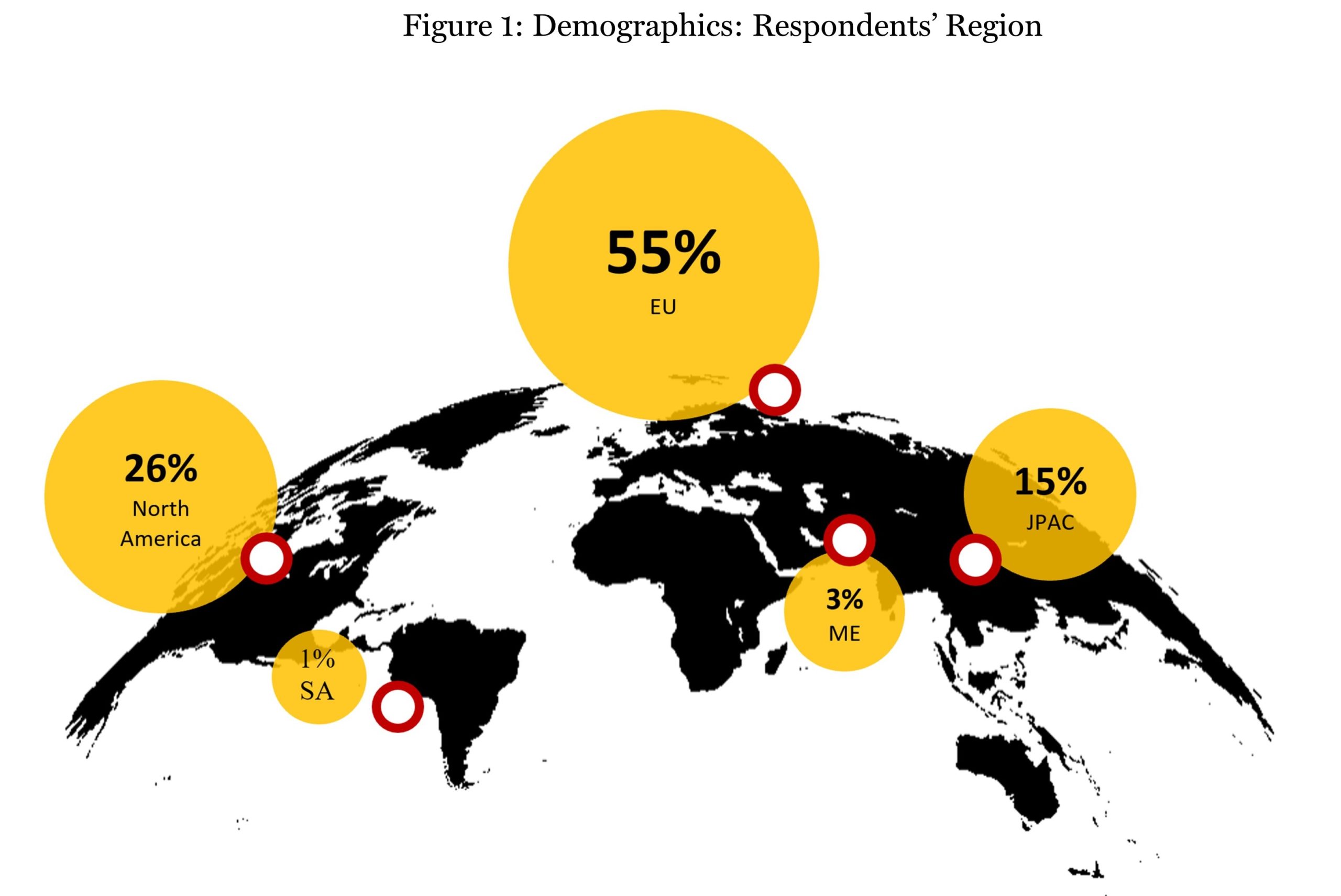 In terms of their roles, 44% of the respondents identified themselves as an MSL director/manager or team leader, involved in defining and tracking MSL KPIs, while 20% of the respondents were MSLs themselves. Then 17% of the responses came from country medical heads, followed by 12% from individuals holding offices of MSL excellence at a global or regional level. There were also responses from regional medical heads (5%), global medical heads (1%), and other medical affairs personnel (1%). The 1% of individuals who mentioned “others” in their response didn’t identify themselves, hence it has been difficult to categorize them.
In terms of their roles, 44% of the respondents identified themselves as an MSL director/manager or team leader, involved in defining and tracking MSL KPIs, while 20% of the respondents were MSLs themselves. Then 17% of the responses came from country medical heads, followed by 12% from individuals holding offices of MSL excellence at a global or regional level. There were also responses from regional medical heads (5%), global medical heads (1%), and other medical affairs personnel (1%). The 1% of individuals who mentioned “others” in their response didn’t identify themselves, hence it has been difficult to categorize them.
 Results
Results
Quantitative KPIs
When asked, “Thinking of the QUANTITATIVE KPIs/Metrics, can you answer which of the following you are currently using and which ones will you use for the next 6 months to 1 year post COVID-19 scenario,” the most commonly measured quantitative KPIs were:
- total number of EE/KOL/HCP engagement
- percentage coverage of EEs from the medical affairs defined EE list and
- type of engagement such as face to face (f2f) or virtual engagement
The results demonstrate that the total number of EE/KOL/HCP engagements and type of engagement should remain among the future KPI. The exception was percentage coverage of EEs, where over a quarter of the respondents outline that they have not yet decided if this component should remain as a KPI.
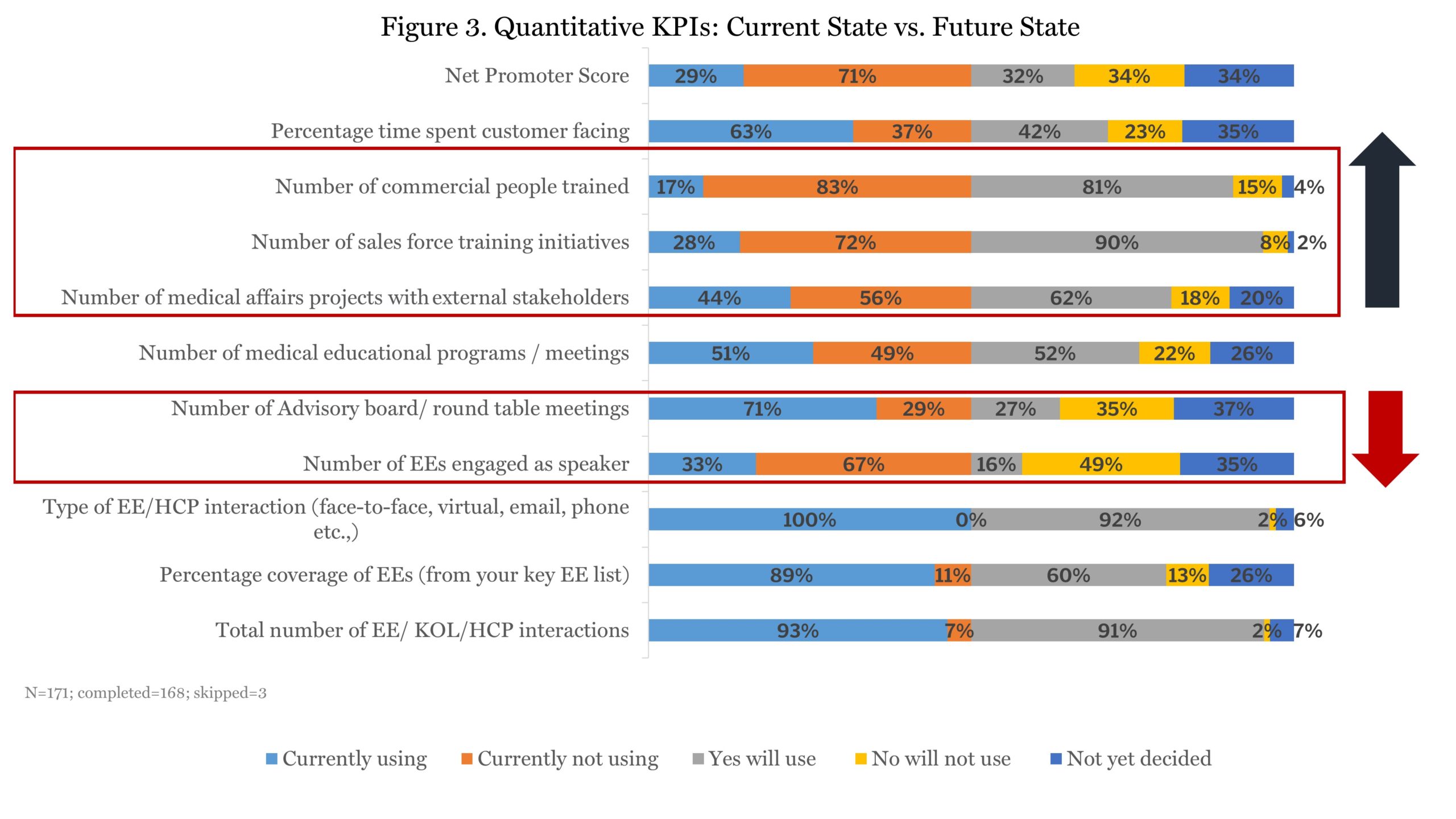 Looking into the KPIs that showed a significant change between pre- and post-COVID-19 scenarios, both the number of advisory boards/round table meetings and the number of EEs engaged as speakers saw significant decline.
Looking into the KPIs that showed a significant change between pre- and post-COVID-19 scenarios, both the number of advisory boards/round table meetings and the number of EEs engaged as speakers saw significant decline.
Over a third of the respondents said that they will not use number of advisory board/round table meetings as a KPI measure in future state, with over a third undecided. When it comes to measuring EEs engaged as speakers, close to half of the respondents said they will not use this measure in future state, while more than a third were undecided. This could be due to the fact that the COVID-19 lockdown has had a huge impact on such close one-to-one meetings directly as a result of social distancing and travel restrictions.
Conversely, the perception of respondents was that parameters such as number of commercial colleagues trained, number of sales force focused training initiatives, and capturing the number of medical affairs projects have seen significant positive change in comparison to pre-COVID-19 situation. This can be directly attributed to the significant increase in the amount of time spent on internal training initiatives by the members of the field force during the lockdown period, and increased involvement of medical affairs colleagues in training the sales force/commercial organization.
When asked “Thinking of the QUALITATIVE KPIs/Metrics, can you answer which of the following you are currently using and which ones will you use for the next 6 months to 1 year post COVID-19 scenario,” the study found that feedback from external stakeholders and insights are the KPIs that are commonly measured.
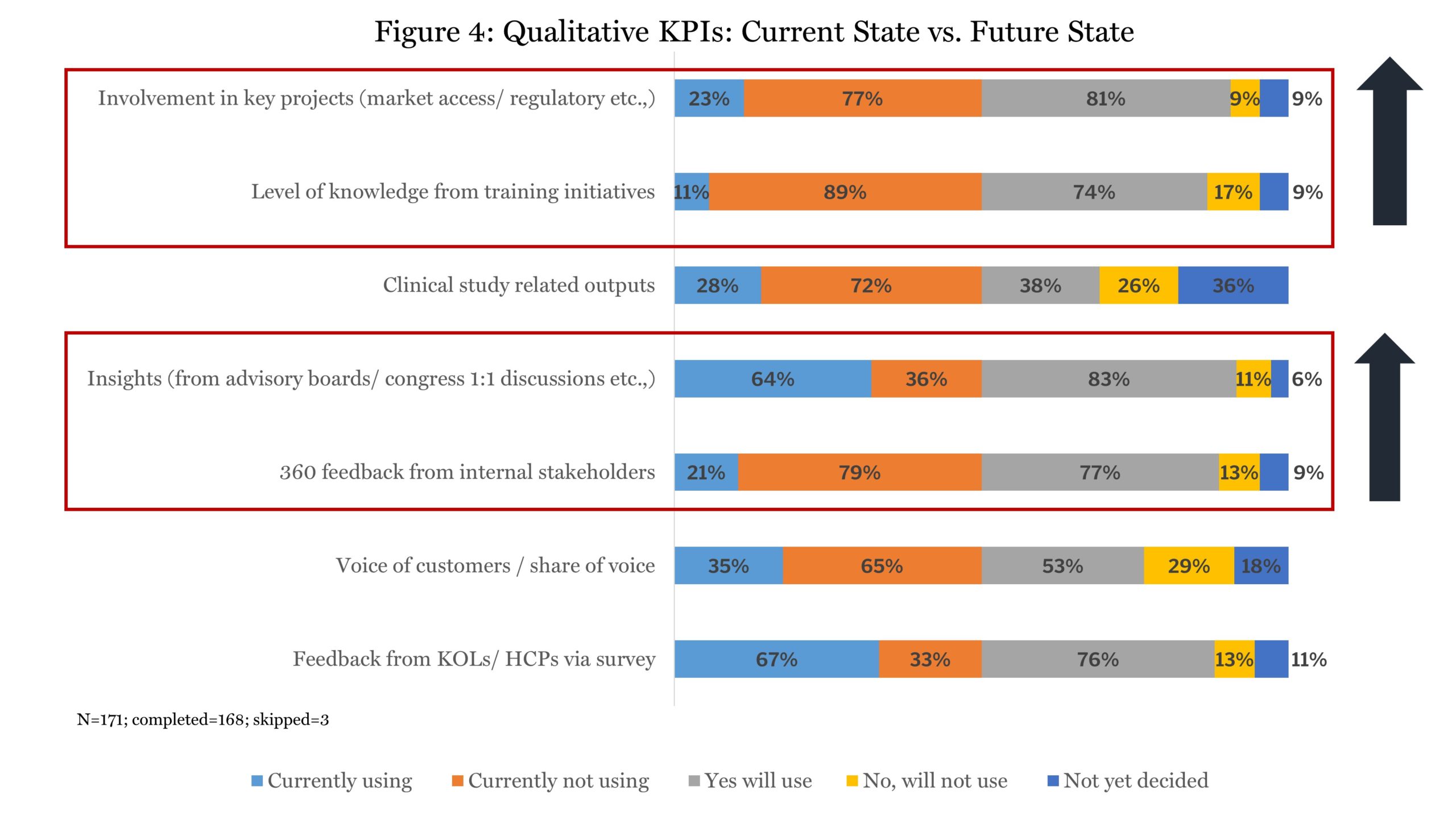 Measures capturing involvement in key projects and recording the level of knowledge of trainees from the training initiatives have seen a significant shift with the respondents indicating that they will include these measures in their future state KPIs, along with key medical insights and 360° feedback from internal stakeholders. These elements demonstrate the value that medical affairs organizations add to the business. It is safe to say that since the customer face-to-face engagement has seen a significant reduction, qualitative elements such as the below have been captured to reflect the contribution of medical affairs to the business.
Measures capturing involvement in key projects and recording the level of knowledge of trainees from the training initiatives have seen a significant shift with the respondents indicating that they will include these measures in their future state KPIs, along with key medical insights and 360° feedback from internal stakeholders. These elements demonstrate the value that medical affairs organizations add to the business. It is safe to say that since the customer face-to-face engagement has seen a significant reduction, qualitative elements such as the below have been captured to reflect the contribution of medical affairs to the business.
 The final question was to understand how in the respondents’ opinions, medical affairs and commercial organization view MSL KPIs during and after the COVID-19 situation. When asked if current MSL KPIs must remain unchanged, 67% of the respondents agree that the MSL KPIs should be adapted to reflect the activities in place following the emergence of the pandemic. Meanwhile, 63% of the respondents said that their commercial counterparts also think that MSL KPIs should be altered.
The final question was to understand how in the respondents’ opinions, medical affairs and commercial organization view MSL KPIs during and after the COVID-19 situation. When asked if current MSL KPIs must remain unchanged, 67% of the respondents agree that the MSL KPIs should be adapted to reflect the activities in place following the emergence of the pandemic. Meanwhile, 63% of the respondents said that their commercial counterparts also think that MSL KPIs should be altered.
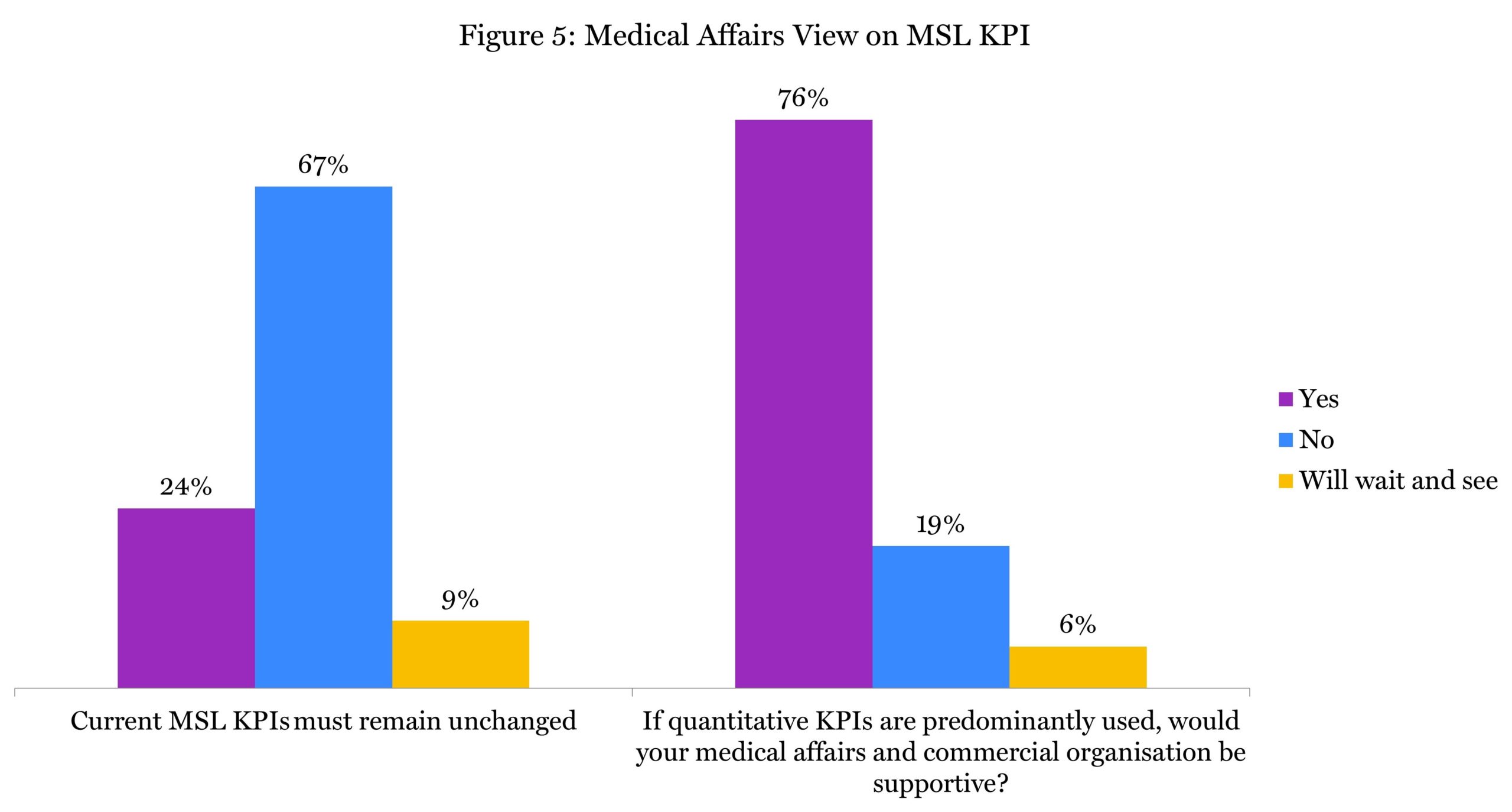 When asked “If quantitative KPIs are predominantly used, would your medical affairs and commercial organization be supportive?” an overwhelming majority of respondents answered yes. However, there is a slight difference between medical and commercial views, with 76% of the medical affairs colleagues believing in more qualitative parameters being used in comparison to only 57% of respondents believing that their commercial colleagues support more qualitative measures over quantitative KPIs. This finding, however, would need to be validated in future survey of commercial colleagues.
When asked “If quantitative KPIs are predominantly used, would your medical affairs and commercial organization be supportive?” an overwhelming majority of respondents answered yes. However, there is a slight difference between medical and commercial views, with 76% of the medical affairs colleagues believing in more qualitative parameters being used in comparison to only 57% of respondents believing that their commercial colleagues support more qualitative measures over quantitative KPIs. This finding, however, would need to be validated in future survey of commercial colleagues.
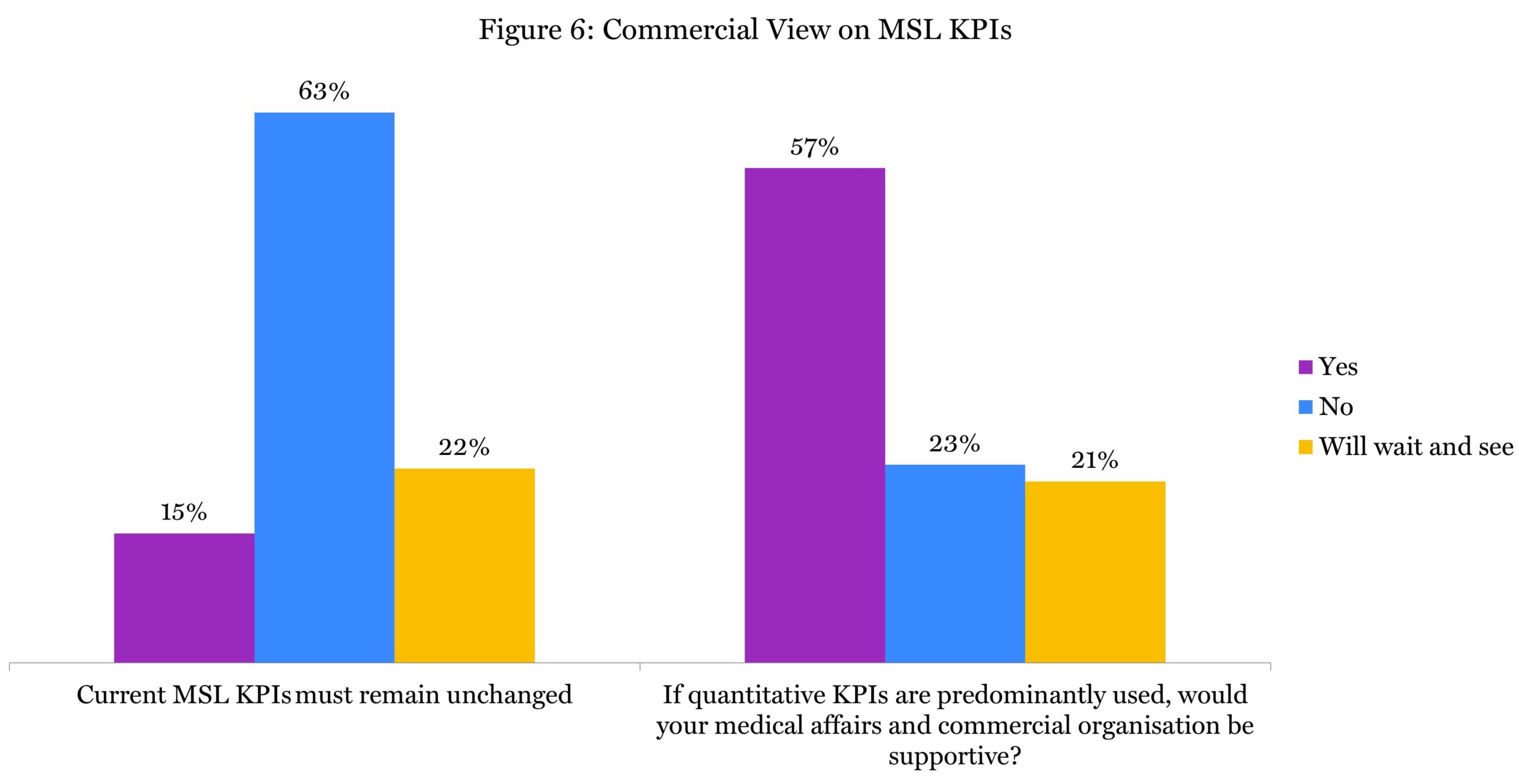 Conclusions and Recommendations for Future Research
Conclusions and Recommendations for Future Research
With responses from more than 170 medical affairs specialists across the world, majority of whom is in the capacity of designing and monitoring MSL KPIs, it is evident that the commonly used MSL KPIs are total number of EE/KOL/HCP engagements, percentage coverage of EEs from the medical affairs defined EE list, and type of engagement such as face to face or virtual engagement. The survey results indicate that these MSL KPI elements seem to be unchanged both in pre- and post-COVID-19 situations.
Quantitative and qualitative KPIs capturing parameters such as number of commercial people trained, number of sales force training initiatives, and the number of medical affairs projects are seen as significantly increasing in the future in comparison to pre-COVID-19 situation.
Please note that this is during the pandemic peak when customer facing time dropped, which resulted in more time for training initiatives. This might not be the case in the next six to 12 months.
Limitations of This Study
There were several limitations to this research. Although this survey had responses from all around the world, the number of responses received from Asian countries were lower in comparison to North America and Europe. In addition, this research was not designed to identify the differences in responses between the regions. Hence any future research should be designed to identify the differences in practices across difference regions. The emergence from COVID-19 has been rapid in some countries such as Germany, China, South Korea, hence resumption of face-to-face activities may be reinstated sooner than six months. The role of virtual meetings that are currently being welcomed by stakeholders is also worth mentioning. Hence this cannel of engagement may be used in lieu of face to face, but still should be measured qualitatively and quantitatively.
References:
1. https://pharmafield.co.uk/in_depth/understanding-the-role-of-the-msl/. Accessed on 18 June 2020.
2. Simon King, “Survey Results: Drug Sales Rep Numbers Could Fall as COVID-19 Lockdowns are Eased.” Physician Views Desk; June 9 2020.






